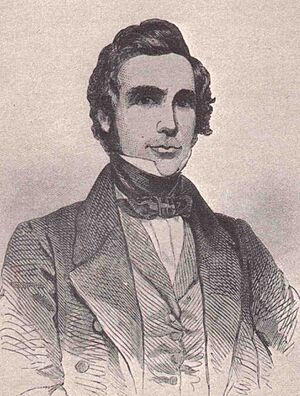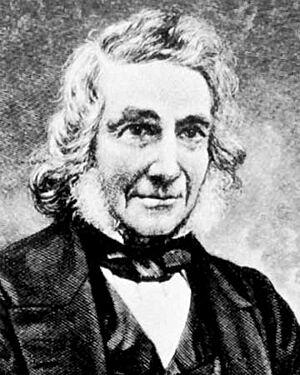William Lovett facts for kids
William Lovett (born May 8, 1800 – died August 8, 1877) was an important British activist. He was a key leader of the Chartist political movement. Lovett was known as a leading working-class activist in London during his time.
He believed that people could gain political rights through peaceful pressure and non-violent actions. After being in prison for a year (1839–1840) for a political charge, Lovett stepped back from more public political work. He then focused on the National Association for Promoting the Political and Social Improvement of the People. This group aimed to make life better for poor workers and their children through education based on Chartist ideas.
Contents
William Lovett: A Life for Change
Early Efforts for Workers
William Lovett was born in Newlyn, a town in Cornwall, in 1800. As a young man, he moved to London to find work as a cabinet maker. He taught himself many things and became a member, and later president, of the Cabinetmakers Society.
He became well-known across the country when he started the Anti-Militia Association. Their slogan was 'no vote, no musket,' meaning if you can't vote, you shouldn't have to fight in the army. He was also active in trade unions, which are groups that protect workers' rights. He joined the Metropolitan Trades Union and supported ideas from Robert Owen, who believed in creating better communities for workers.
In 1831, during the time of the Reform Act, he helped create the National Union of the Working Classes. He worked with other activists like Henry Hetherington and James Watson. After the Reform Act passed, he joined Hetherington in a campaign to remove taxes on newspapers. This was known as the "War of the Unstamped."
Starting the London Working Men's Association
In June 1836, Lovett founded the London Working Men's Association (LWMA) with several fellow activists, including Henry Hetherington. The LWMA had a limit of 100 working-class members. However, it also allowed 35 honorary members, including Feargus O'Connor, who later became a Chartist leader.
Other honorary members included some Members of Parliament (MPs). But the LWMA was mainly a working-class group. This was different from groups like the Birmingham Political Union, which had many middle-class leaders. The LWMA's first goal was education.
In 1838, Lovett and another activist, Francis Place, wrote a plan for a new law. This plan became the basis for the Peoples' Charter. Because of this, the Association became very involved in the Chartist movement. Lovett and five other LWMA members signed the plan, along with six activist MPs, including Daniel O'Connell.
Lovett is most famous for his part in the Chartist movement. Chartism was a campaign for changes in Parliament. These changes aimed to fix unfairness that remained after the Reform Act of 1832. The movement lasted from about 1838 to 1850.
Time in Prison
Like many Chartist leaders, Lovett was arrested. In February 1839, the first Chartist Convention met in London. On February 4, 1839, they all voted for Lovett to be their Secretary.
On May 13, 1839, the Convention moved to Birmingham. Many supporters gathered in the city's Bull Ring. However, local officials had said that no meetings could happen there. Several people were arrested. The Convention said that the police were wrong to break up the "riot." They put up posters that called the police a "bloodthirsty and unconstitutional force."
As secretary, Lovett took responsibility for these posters. He was arrested along with John Collins, who had taken the posters to a printer. Lovett and Collins were later found guilty of a political charge. They were sentenced to twelve months in Warwick Gaol (prison). They were set free in July 1840.
A New Path: Education for All
While in prison, Lovett and Collins wrote a book called "Chartism, a New Organisation of the People." This book focused on Chartist Education. After he was released, Lovett stepped away from direct politics. In 1841, he started the National Association for Promoting the Political and Social Improvement of the People. This was an educational group.
The group aimed to put his "New Move" education plan into action. Through this plan, he hoped that poor workers and their children could improve their lives. The New Move was supposed to be paid for by Chartists who signed the national petition, with each person paying one penny per week.
Henry Hetherington and Francis Place supported this idea. However, Feargus O'Connor was against the plan. He wrote in his newspaper, the Northern Star, that he believed it would make Chartists forget their main goal of getting the petition passed.
The New Move did not get as much public support as Lovett had hoped. It never had more than 500 members. Education was mostly limited to Sunday schools. The National Association Hall opened in 1842, but it closed in 1857 when the group was forced to leave. In the 1851 Census, Lovett said he was a school teacher. In the 1861 and 1871 Censuses, he was listed as a teacher of physiology (how the body works).
William Lovett's Beliefs
Lovett was a "moral-force" Chartist. This means he believed in using peaceful methods, not violence, to achieve political change. He also believed in the temperance movement, which encouraged people to avoid alcohol. He was a strong supporter of being sober. He also had different ideas about teaching than most people at the time. He believed in teaching methods based on kindness and understanding.
Personal Life
William Lovett's father sadly drowned before William was born.
In 1826, he married Mary Solly from Pegwell, Kent. She was a great support to him in all his work. They had two daughters together.
In his later years, Lovett opened a bookshop. He also finished writing his autobiography, called The Life and Struggles of William Lovett, in 1877.
He passed away on August 8, 1877, without much money. He was buried on the western side of Highgate Cemetery. His grave is now a special monument, listed as a grade II historic building.




